You are here:
- Procedures / Keratoconus / Corneal transplantation
Corneal Transplantation for Keratoconus
What is Keratoconus?
Keratoconus is a common cause of poor vision in young people caused by a progressive abnormality of corneal shape.
The cornea is the clear part of the front of the eye wall. You need a regular corneal curvature to help focus light accurately through the eye onto the retina.
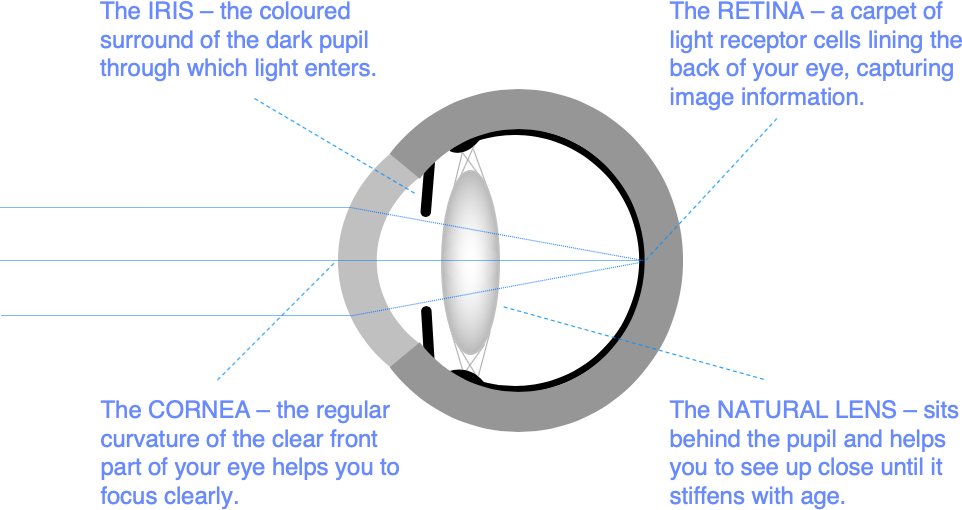
In keratoconus, your cornea gradually bulges forwards, becomes thinner, and more irregular. It typically gets worse in the teenage years and through your 20s, before stabilising in your 30s. Although it is genetically determined, only about 10% of people with keratoconus have another affected family member, and one eye is often worse affected than the other.
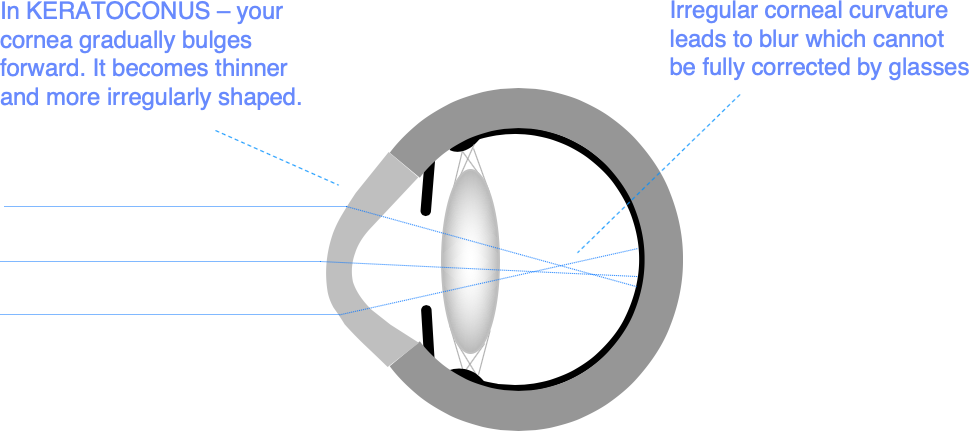
We are now able to intercept keratoconus progression at a relatively early stage using treatments like corneal crosslinking (CXL), TransPRK/CXL, and ICRS. But these treatments are not always successful, and you may only become aware that you have keratoconus when it is already too advanced for these treatments to work well. At this stage, corneal transplantation is often the best treatment option.
What is corneal transplantation?
Corneal transplantation for keratoconus remains common, and accounts for about 1 in 4 of all corneal transplants performed.
The operation involves replacing the abnormally shaped central part of your cornea with a similar sized central part of a normal donor cornea. The donor corneal tissue is called a corneal transplant or corneal graft, and the operation is called corneal transplantation or “keratoplasty”. Laser techniques or conventional microsurgery are used to optimise fit. The donor cornea is fixed in place with sutures that are normally removed after a period of healing lasting 6-18 months.
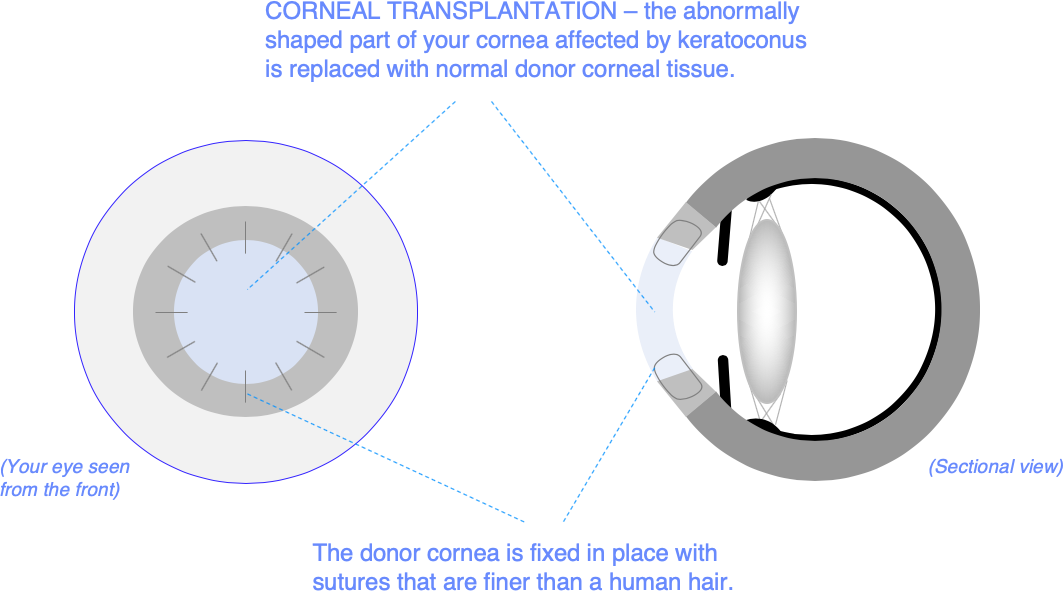
Corneal transplantation for keratoconus is a day case procedure that is normally performed under general anaesthetic. You do not need to stay overnight in hospital, but you need two weeks off work to help your recovery. You also need to be able to attend regular hospital review appointments during your recovery to ensure that everything is on-track for a good result.
Corneal transplantation for keratoconus is elective (non-emergency) surgery – if you delay going ahead, it does not normally affect the end result.
What are the benefits of corneal transplantation?
Corneal transplantation results in a dramatic improvement in vision for most patients. About 4 out of 5 are able to see at the driving standard or better in glasses again within a year of corneal transplantation.
For those that do not see well initially, revision surgery using incisional or laser techniques is often very effective in improving vision. You may require more than one of these relatively minor revision procedures to help achieve the best end result.
Corneal transplants provide a lasting benefit for most patients, but repeat surgery is sometimes needed. About 19 out of 20 corneal transplants performed for keratoconus is successful and stays clear for at least 5 years.
Who is suitable for corneal transplantation?
If you have advanced keratoconus and are unable to wear contact lenses successfully, corneal transplantation is normally your best treatment option.
Less commonly, you may need corneal transplantation if you have complications after other keratoconus treatments or you have had a corneal infection associated with contact lens wear.
Corneal transplants are also performed for a range of corneal problems other than keratoconus.
What are the alternatives?
Two types of corneal transplant are commonly used to restore a normal corneal shape in advanced cases of keratoconus: PK and DALK.
Conventional corneal transplantation - PK
In conventional corneal transplantation, the full thickness of the front of the eye wall is replaced by a disc shaped piece of donor corneal tissue which is sewn into place. The circular wound heals gradually, and the sutures are normally removed 1 to 2 years after surgery. This form of corneal transplantation is also called full-thickness corneal transplantation, or PK (“penetrating keratoplasty).
PK is still commonly preferred in keratoconus, particularly where there has been scarring or damage to the back layers of the cornea in later stage disease. It is the most widely used type of corneal transplant for the treatment of advanced keratoconus.
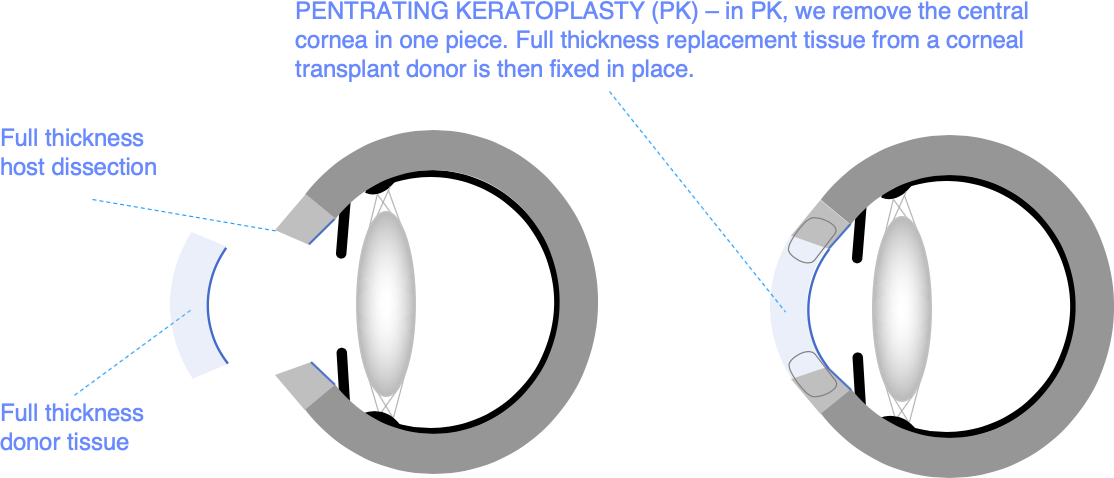
Partial thickness corneal transplantation – DALK
For many patients with keratoconus requiring corneal transplantation, the delicate pump cell layer lining the back of the cornea (the corneal endothelium) and the thin supporting layers (Descemet’s membrane and the pre-Descemet layer) remain normal. If this is the case, we usually recommend selective replacement of the abnormally shaped front 95% of the cornea, leaving these thin back layers in place. This version of corneal transplantation is called DALK (“Deep Anterior Lamellar Keratoplasty”).
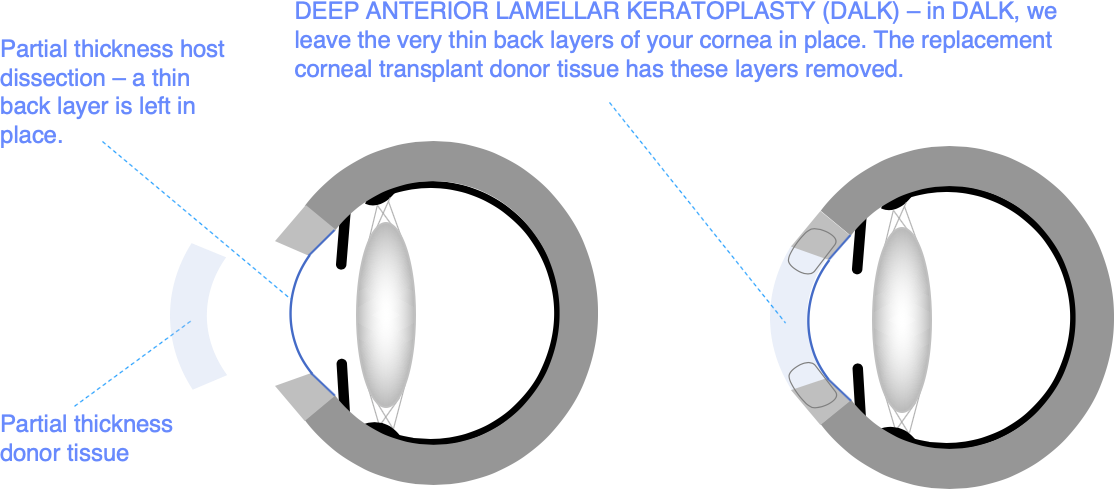
DALK reduces the risk of problems with transplant rejection and the likelihood that your corneal transplant will need to be replaced in future. But it is a technically demanding procedure. In about 1 case in 20, we start with the intention of performing DALK but convert the operation to PK during surgery because the thin back layers of your cornea cannot be preserved intact. If this occurs, you should not be unduly disappointed. All corneal transplantation techniques for advanced keratoconus produce good results. PK has some advantages of its own, and the debate about which technique is best for keratoconus remains open.
Femtosecond laser assisted DALK
Femtosecond lasers can be used to cut almost any 3D shape in the cornea. This class of lasers is commonly used in surgery to help correct the need for glasses. We have developed femtosecond laser assisted techniques designed to make DALK easier. If you are suitable for laser assisted DALK, we will discuss this variation in technique with you at your preoperative consultation.
Scleral and mini-scleral contact lenses
In advanced keratoconus, contact lenses designed to fit to the corneal surface are often no longer comfortable or stable on your eyes. This is because the shape of your cornea has become too irregular and too steeply curved. At this stage, scleral or mini-scleral contact lenses can be a good solution, and a useful alternative to corneal transplantation. Instead of resting on the cornea, these lenses rest on the white of the eye (the sclera) and vault over the cornea, with the space behind filled with liquid prior to lens insertion.
Scleral lenses do not work for everyone, but they are a useful alternative to corneal transplantation for advanced keratoconus. We have optometrists with experience in medical contact lens fitting for keratoconus at Moorfields who can help you explore all the contact lens alternatives to surgery, including scleral and mini-scleral lenses.
How is corneal transplantation performed?
PK and DALK are day case procedures which are most commonly performed under general anaesthetic. Alternatively, we can use local anaesthetic with relaxant medication. Local anaesthetic is washed around the back of the eye after the application of numbing drops, and relaxant drugs are administered through an injection in your hand.
In femtosecond laser assisted DALK, we cut the templates for both the donor cornea and your own cornea using drop anaesthetic in the laser theatres as a preliminary stage, before transporting you to main theatres for completion of the surgery. Note that femtosecond lasers work by tracing a pre-programmed 3D pattern of microscopic gas bubbles through the target tissues. Your cornea is therefore still intact when you are transferred to main theatres. Specialised ‘bladeless’ surgical instruments are then used for tissue separation exactly along the templates defined by the laser.
Key stages in surgery are:
- Donor preparation – donor corneal tissue is processed and quality checked by an eye bank before being supplied to Moorfields. We cut this donor tissue into a custom shape using either a femtosecond laser or specialised instruments in conventional microsurgery.
- Host preparation – a reciprocal portion of your abnormally shaped cornea is removed using either a femtosecond laser or specialised instruments in conventional microsurgery.
- Donor fixation – the donor cornea is fitted into your own cornea after dissection and secured in place with sutures. These sutures are finer than a human hair and are not visible after surgery.
What are the risks?
In all forms of eye surgery, problems can occur during the operation or afterwards in the healing period. Problems can result in permanent, serious loss of vision (vision worse than the driving standard in the affected eye that cannot be corrected with glasses or contact lenses). More commonly, problems can be corrected with changes in medication or additional surgery.
Loss of vision
If you are having a corneal transplant for advanced keratoconus, your eyesight is normally already very poor in the eye we are operating on. It is therefore unusual for your vision to end up worse after surgery than before. But permanent visual loss can still occur due to complications resulting from surgery that damage the retina or the optic nerve. This may mean vision worse than the driving standard or, in some cases, complete loss of vision in the affected eye.
Additional Surgery
Once we have removed your corneal sutures, and your initial healing is complete, we commonly need to do additional minor revision surgical procedures to get the best final visual result. These revision procedures aim to improve the focusing shape of your new cornea. Examples are:
- Astigmatic keratotomy – relaxing incisions made with either a femtosecond laser or specialised surgical instruments are used to flatten out areas of the cornea that are too steeply curved.
- Wound revision – if the edge to edge match of your transplanted cornea and your own cornea slips during healing, this can affect curvature and focus. We sometimes need to start again in one or more areas of your transplant, by opening the wound and re-suturing in order to get a better edge to edge match.
- Laser vision correction – if we need to fine-tune the surface shape, sometimes as a follow-on from the procedures above, we often use laser vision correction techniques like TransPRK and LASIK.
- Lens implantation – you may develop a cataract after surgery. This is an opportunity to select a lens that can correct high levels of short sight that can remain after corneal transplantation for keratoconus. If you do not have a cataract, ICL implantation is also very effective at correcting a high residual spectacle prescription.
Graft failure
If your corneal transplant fails to clear, or becomes permanently cloudy at some point in the years after transplantation, this is called corneal transplant failure (also called “graft failure”). If graft failure occurs, repeat corneal transplantation is normally possible. Success rates for repeat surgery in PK diminish with each successive graft, but they are still good, and many people have corneal transplantation surgery more than once in the same eye.
Initial graft failure rates for DALK and PK are about the same, with approximately 19 out of 20 patients keeping a clear graft for 5 years or more.
In PK, about 9 out of 10 patients keep a clear graft for over 10 years, but failure rates increase between 20 and 30 years after surgery. So, it is common to need a second corneal transplant at some stage.
The commonest reason for a PK to fail is corneal endothelial failure, in which the pump cell layer called the corneal endothelium lining the back of your cornea stops working, causing the cornea to become waterlogged and misty. If corneal endothelial failure is the problem, and your original corneal transplant had a good focusing shape, rather than starting again with another PK, we can often selectively replace the failed endothelial layer with a keyhole operation called DMEK. This operation has a relatively fast recovery and is relatively easy to repeat.
Corneal endothelial failure is much less common after DALK, and long-term graft survival should be better as a result. This is one of the main advantages claimed for DALK, but it will be several years before we know definitively whether current DALK techniques do indeed lead to better long-term protection from graft failure.
Graft rejection
Transplant rejection is an inflammatory reaction to donor cells caused by your body’s immune system.
Unlike, say, kidney or heart transplantation, most patients treated with corneal transplants do not benefit from either tissue matching (tissue from a donor with some cell markers similar to your own) or systemic immunosuppression (powerful drugs to suppress your immune system).
Approximately 1 in 3 patients with a PK have at least one rejection episode in the first 2 years after surgery. For DALK cases, it is about 1 patient in 5. To reduce the risk, you should ensure that you take your postoperative drops as instructed after surgery. We normally continue steroid eye drops in a low dose for two years after surgery, and we sometimes continue in the longer-term if we think you are still at risk for problems with graft rejection.
If you experience Redness, Sensitivity to light, Visual blurring, or Pain (“RSVP”) at any stage after corneal transplantation, you should reattend via the Casualty Service without delay to make sure that you do not have a graft rejection episode. Graft rejection can normally be treated successfully with an increase in steroid drop treatment, but delays in treatment or repeated episodes can lead to graft failure.
There are reports that the influenza vaccination (‘flu vaccine’) may precipitate a corneal graft rejection episode. The risk of this occurring is likely to be low, and you should certainly not refuse vaccination because you are worried about this. To cover this risk, we currently advise that you should ask your local doctor to prescribe a 2-week course of steroid eye drops (Dexamethasone 0.1% or Pred Forte) to be taken 4 times daily from the day of vaccination.
Steroid induced glaucoma
Steroid eye drops help protect from rejection, but they can cause the fluid pressure in your eye to rise. We screen for this with an eye pressure test at your postoperative clinic visits, and we often prescribe additional eye drops to lower the fluid pressure if we find that it is high. If left untreated, high fluid pressure can damage the optic nerve at the back of your eye. So, it is important to attend your hospital review visits, and to take any additional eye drops that we prescribe in the period in which we need to continue with steroid eye drops.
What are the side effects?
Side effects are problems which most patients experience to some degree after surgery. They normally improve with time, but do not always resolve completely.
Vision
Temporary blurring of vision is normal after corneal transplantation, but most patients find that the vision clears in the first 3 months after surgery, with continued improvements after that. Your vision may initially be worse after surgery than before, and the speed of recovery is very variable. If you have blurred vision at first, it does not mean that you are not going to get a good final visual result.
Eye comfort
For the first 1-2 weeks after DALK or PK, it is normal for the eye to feel gritty and watery. Use your drops regularly as instructed, and your comfort will soon settle. Continued eye surface discomfort is common in the early months after most forms of eye surgery, including DALK and PK. Treatment and prevention are based on making sure your eye surface is healthy before and after surgery, particularly in relation to allergic conjunctivitis, which affects many people who have keratoconus. Lubricant eye drops can be helpful, and can be taken safely in addition to your other medication when required. For patients with a normal eye surface prior to surgery, lasting problems are unusual.
Eye Appearance
Red blotches are often visible on the white of the eye after any form of eye surgery. These are called subconjunctival haemorrhages, and are caused by a small leak of blood under the mucous membrane covering the white part of eye wall. Although they can be quite unsightly, red blotches are temporary, and do not affect eye health; but they can take up to 6 weeks to go away completely.
Will corneal transplantation affect my future eye care?
If you develop a new eye health problem in later life, corneal transplantation should not prevent you having successful treatment. Common eye health problems like cataract, glaucoma, diabetic retinopathy, and age-related macular degeneration can be monitored and treated as normal after DALK or PK.
Future surgical treatment can sometimes precipitate graft failure. If surgery is planned, we can give you advice on the risk of graft failure by checking the health of your corneal endothelial cell layer with specialised imaging tests.
We normally recommend that you continue to review your eye health once a year under the care of your local optometrist after you have been discharged from routine postoperative clinic review at Moorfields.
How can I reduce the risk of problems?
Most patients have corneal transplantation for keratoconus under general anaesthetic. You should not eat or drink for six hours before surgery under general anaesthetic, other than a sip of water to take your regular medication.
For patients having surgery under local anaesthetic, fasting before surgery is not required. We work with an anaesthetist to monitor your health during surgery and optimize your comfort, administering sedation where necessary. Keep your breathing calm, stay as relaxed as you can, and try to keep your head still after the surgeon has positioned it comfortably.
You should clean off any make-up or moisturising cream before surgery to help the adhesive surgical drape that we use to stick properly around your eye.
We normally cover the eye with a pad at the end of surgery, and we administer the drugs that the eye needs for healing at the end of surgery. You can remove the pad and start your drop medication from the following day.
You can wash and shower normally from day one after surgery. We recommend no swimming until we have seen you in clinic and confirmed that your corneal skin layer has healed, usually by 2-3 weeks after surgery. We will also advise you about driving at your postoperative review. 2 weeks off work are normally required to help you concentrate on administering your eye drops and recover from the initial discomfort.
Set a smart phone reminder and use the antibiotic and anti-inflammatory drops as prescribed to help the eyes to heal well. It is good to leave at least 2 minutes between different types of eye drop so that they each absorb well before the next drop is applied. If you miss the first time or you are not sure, applying a second eye drop is no problem.
Gritty discomfort is normal in the first few days after surgery. But you should contact us without delay if you have building, aching pain in the eye (like a headache in the eye) or if you have a sudden loss of vision or an injury to the eye resulting in increased pain and blur. To help protect the eye from injury, you should wear sports eye protection for contact sports and ball sports for life after either DALK or PK.
The Eye Casualty Department at Moorfields Eye Hospital is open for emergency review 24 hours a day, 7 days a week.
Remember ‘RSVP’ – increasing redness, sensitivity to light, visual blurring, or pain. These are the warning signs of a corneal transplant rejection episode. If you experience any of these symptoms, it is best to attend via the Casualty Service to make sure you do not need additional treatment. You should also attend via the Casualty Service is the eye gets red and if feels like you have a piece of grit under your eyelid – this kind of discomfort can be caused be a loose suture.
You may not be aware of a problem that requires treatment in the healing phase. So, make sure you attend your review appointments even if your eyes feel good.
Appointments and enquiries
To arrange a private consultation, please telephone Angelique Thomas on 020 7566 2156 or 07484 081815 (or from outside the UK +44 20 7566 2156 or +44 7484 081815) or email moorfields.ballan@nhs.net
For NHS treatment with Mr Allan’s team at Moorfields, you will need a referral from your GP or Ophthalmic Surgeon. Referrals should be addressed to Mr Bruce Allan, Consultant Ophthalmic Surgeon, Moorfields Eye Hospital, City Rd, London EC1V 2PD. If you have any difficulty with your NHS referral, please call Barbara Stacey, NHS secretary to Mr Allan on 020 7566 2320, or email barbarastacey@nhs.net.
